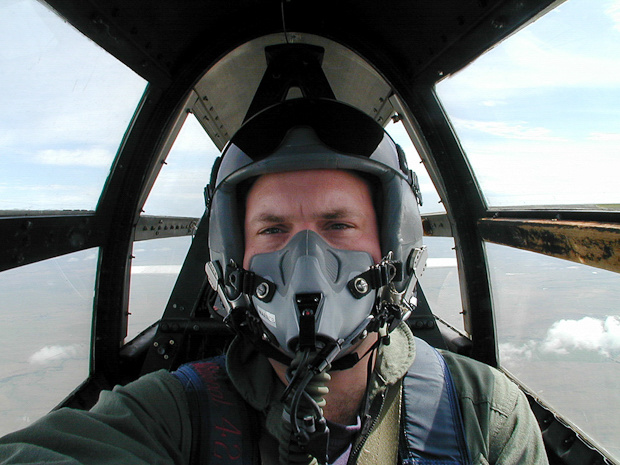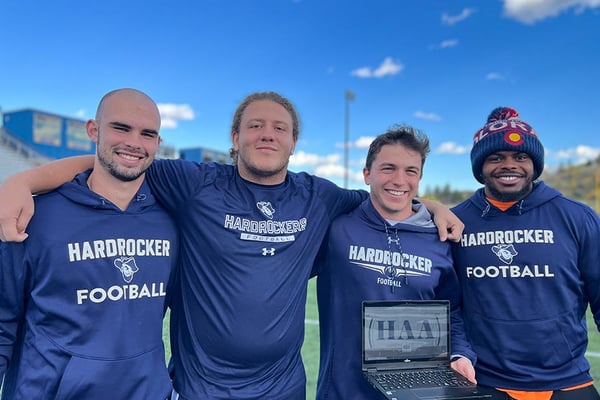Imagine hopping inside an extensively modified T-28 aircraft, knowing that you (and you alone) were about to fly it directly into a hailstorm – on purpose.
That’s exactly what Tom Warner (ATM 04), B-1B pilot with the U.S. Air Force and meteorologist, did for four years. The T-28 storm penetrating research aircraft was part of the National Hail Research Experiment (NHRE) and was housed at South Dakota School of Mines & Technology’s Institute of Atmospheric Sciences (IAS) from 1969 (when it was acquired) until retirement in 2005. The T-28 armored plane flown by Tom and eight others more than 30 years of scientific research was specifically developed for in situ observations of hailstorms. Twenty years after its retirement, several involved are now archiving the data from the plane and reflecting on its significance.
“In the 1960s, about 10 percent of crops on the western high plains were being lost every year due to hail,” explained Dr. Andrew Detwiler, professor emeritus of physics & atmospheric sciences and one of the controllers helping guide Tom as he flew through storms. “Scientists in the Soviet Union were claiming they could use cloud seeding to suppress formation of hail in large thunderstorms and reduce crop damage. So, Congress made it a priority to research this and figure out more about how hailstorms worked. One way to explore that is to fly something into a hailstorm and observe what’s going on.”
In 1968, the National Science Foundation funded the IAS to develop an armored research airplane. In the 1970’s the National Hail Research Experiment (NHRE) was funded by the NSF and several other government agencies. It gathered a dozen research aircraft with various capabilities including the armored T-28, along with a large number of radars and surface instrumentation networks to conduct a multi-year study. The results of the study showed that, at least in the U.S. High Plains, hail suppression like that claimed by Soviet scientists was not achievable. Thunderstorms were complex and hard to understand. Research continued worldwide and the IAS and T-28 stayed involved. It flew in research projects in the United States, Canada, and Switzerland.
In late 1987, in order to make the T-28 more widely available, the IAS joined into a cooperative agreement with the NSF to operate the aircraft as a national research facility, allowing researchers around the world to request its resources for their studies. Under this agreement, the T-28 facility staff supported 18 projects that studied the development of hail, rain, and other advanced meteorological research.
In the early 2000s, Dr. Donna Kliche (MTRO 90), professor emerita of mathematics & atmospheric sciences at Mines, joined the T-28 facility staff. She helped analyze the data after each flight. Dr. Kliche said the significance of the T-28’s impact on the field should not be overlooked.
“The measurements collected during these flights helped radar researchers to develop and validate algorithms that help the National Weather Service forecasters to examine storms with more precision,” she said. “Certain advancements in the field have happened because of the data from the T-28. These tools could not have been developed with models alone.”
Andrew said legacy of the aircraft is something to be appreciated.
“The idea that you can get resources and funding to go out and try something that’s never been done, even if you can’t guarantee you will be 100 percent successful, is an era that has passed. Currently, there is a tendency to pursue scientific goals that are safe bets,” Andrew said. “The T-28 aircraft significantly increased our understanding of thunderstorms.”
Tom, who piloted the T-28 from 2000 to 2004, said the uniqueness of the opportunity was what attracted him to the job.
“For me, it wasn’t about the adrenaline,” Tom said. “I was interested in thunderstorms. I also had the background knowledge of being a pilot, and this was an incredible opportunity to feel it up close and personal. Was I nervous? Yes. But I was confident in the aircraft.”
The first time he went up, he remembers his trainer saying, “The airplane knows how to get through the storm. If you stay in the airplane, keep it running and upright, you’ll be okay.”
Tom flew the plane during four research projects, and that experience is what drew him to pursue his master’s degree at Mines. Through his graduate degree, he has studied NSF-sponsored research of lightning that has discovered that some tall objects such as wind turbines experience “upward” lightning much more often than initially anticipated. Due to the damages and failures caused by these lightning strikes, companies that operate and manufacture wind turbines are interested in Tom’s research so they can mitigate these strikes as much as possible, understand the physics behind them, and know how to best protect the turbines.
Twenty years later, Tom recognizes that his time with the T-28 crew is what opened the door for his future career pursuits in research. He said that from an aviator’s perspective, the T-28 aircraft was “absolutely incredible.”
“What that aircraft did was truly historic,” he said. “What we learned from an aviation safety standpoint, including knowing the best action to take if you fly into a storm, was counter to FAA guidance at that time. We were able to get data and piloting experience from a place that no one thought possible, and that was a huge contribution.”
The T-28 archives will be online for public use sometime this summer.



